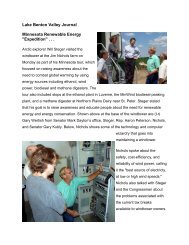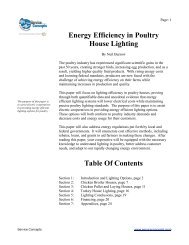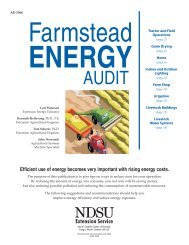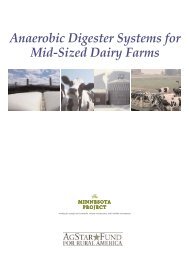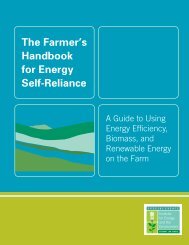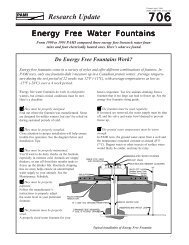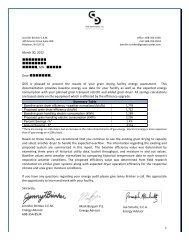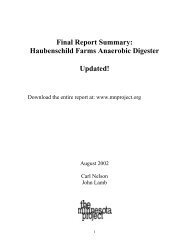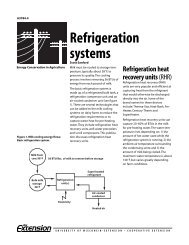Dairy Farm Energy Management Handbook - Wisconsin Department ...
Dairy Farm Energy Management Handbook - Wisconsin Department ...
Dairy Farm Energy Management Handbook - Wisconsin Department ...
You also want an ePaper? Increase the reach of your titles
YUMPU automatically turns print PDFs into web optimized ePapers that Google loves.
Equipment Operation and Maintenance<br />
Tune Up Your Washing System<br />
A basic way to minimize energy usage is to make sure that your washing<br />
systems – including clean-in-place systems – for the bulk tank and milking<br />
system are operating efficiently and properly. These two areas use a lot of<br />
water.<br />
“Annually, have your dairy equipment dealer come in and tune up the cleanin-place<br />
washing systems for the bulk tank and milking system,” advises<br />
Sanford. “To save energy, it’s important to conserve the water and use only<br />
what’s absolutely required for flushing the system.”<br />
A good example of a tune-up is to make sure the air injection system is<br />
working properly and check the settings to make sure you’re using only the<br />
amount of water needed for each wash cycle. In cold climates, wash-solution<br />
volume can often be reduced in the summer. However, remember to increase<br />
it in fall to assure enough thermal mass to maintain proper temperatures. (4)<br />
Time, temperature, concentration, and physical action represent the chief<br />
factors in good cleaning procedures. (5)<br />
For example, cleaning solutions need some time to work. In most farm<br />
equipment cleaning, about 10 minutes is adequate to dissolve or suspend<br />
milk solids.<br />
Hot water is critical to emulsify milk fat, to disperse milk proteins, and to<br />
promote good cleaning action. For example, water for chlorinated alkaline<br />
detergent solutions must enter the wash sink at no less than 150°F, and it<br />
must be discharged to the drain at no less than 120° F. (5)<br />
Generally, maintaining adequate cleaning solution temperature is more critical<br />
than the actual washing cycle duration. In short, washing for longer-thanrecommended<br />
times doesn’t necessarily result in better cleaning.<br />
Consequently, it’s suggested to avoid circulating solutions until they cool<br />
below minimum recommended temperatures (120° F.), even if contact time of<br />
the cleaning solution is slightly shorter than recommended. (5)<br />
Always use the recommended amounts of quality cleaners and sanitizers.<br />
Don't try to save money on bargain-priced cleaning chemicals, and carefully<br />
measure the amounts of water and cleaners you use.<br />
Hard water can reduce the effectiveness of dairy cleaning chemicals. Most<br />
package labels will specify the amounts to use per quantity of water,<br />
according to the grains of water hardness.




